The modern world is filled with information from a whole range of sources. With smartphones and other mobile devices, we can instantly tap into all the knowledge of the Internet from practically anywhere on Earth. At least, we can do that as long as all the infrastructure keeps running. When the lights go out so does all that information.
But there’s plenty of information in nature if you know how to read it. It’s short on cat videos and celebrity gossip, though. The problem is that, as a nation, most of us are now so far removed from nature that we don’t know how to read those signs any more.
The early pioneers, and the mountain men and trappers who helped open up the West, were experts at reading the natural world.
Finding your way around
Most of us have GPS nowadays, either on our phone or as a separate handset. It’s a great tool, but you should never rely on it. The best way to navigate is with a map and compass, using GPS as a backup. That way your map-reading skills stay sharp, and you’ll be able to adapt when your GPS battery dies unexpectedly – or when the SHTF and the whole network goes down. But what if your compass gets broken, or you’re caught without any navigation equipment? Luckily, nature has a whole load of navigation tools built in.
The Sun
If the sun’s up, you can always be sure of what direction you’re going in. All you need is a watch or clock that’s set to the right time. An analog watch is best; if you have a digital one you’re going to have to start drawing clock faces in the dirt.
What you have to do is point the hour hand at the sun. Going anticlockwise, half way between the hour hand and 12 o’clock is south (if you’re in the northern hemisphere – if you’re south of the equator it’ll be north). Once you know where south is you have all the rest of the compass points too. As long as you update every 30 minutes to an hour this method is easily accurate enough for emergency navigation. If you’re lost in the woods and need to find the way out, for example, this will do it.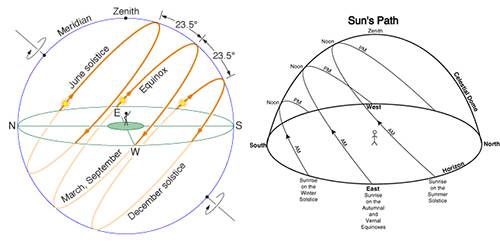
The Pole Star
What if you need to know directions at night? If the sky is clear you just need to look for the constellation of Ursa Major. This has various names – the Great Bear, the Plough, the Wagon and the Big Dipper are a few of them. It looks like this:
Find the stars at the end of the dipper; these are called the Pointer Stars. Now draw an imaginary line through them. Go up five times the distance between the Pointer Stars; close to where you’re now looking is a bright star, brighter than any others in that part of the sky. This star is Polaris, the North Star or Pole Star. If you’re anywhere in the northern hemisphere Polaris is to your north.
Moss
You might have read that moss grows on the north side of tree trunks. It does – sort of. It’s easy to go wrong though, because a little knowledge is a dangerous thing. With just a little bit more, though, you’ll be able to navigate effectively by looking at moss. This can be very useful at night if it’s too cloudy to see the stars – or, if it’s really bad weather, too cloudy to see where the sun is.
The reason moss usually grows on the north side of trunks is that it doesn’t like being dried out. The north side is in shade when the sun’s light is at its strongest, so moss prefers to grow there. But if it’s a section of trunk that’s sloping and has rough bark, so water can lie in it, moss is less fussy. The air close to the ground is usually moist, too, so ignore any moss growing less than two feet above ground level. Look for a vertical trunk with smooth bark; if there’s moss on one side of it, that side is probably north.
The same techniques work for lichen on boulders or stone walls; if there’s no other reason for it to stay moist, it’s probably the north side.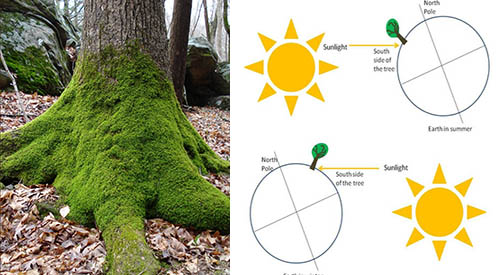
Locating Game
Wild animals are elusive, but if you know what you’re doing you can read the signs that show you where you are and what they’re doing. This is a huge subject, but it’s not hard to pick up some basics and develop your knowledge from there.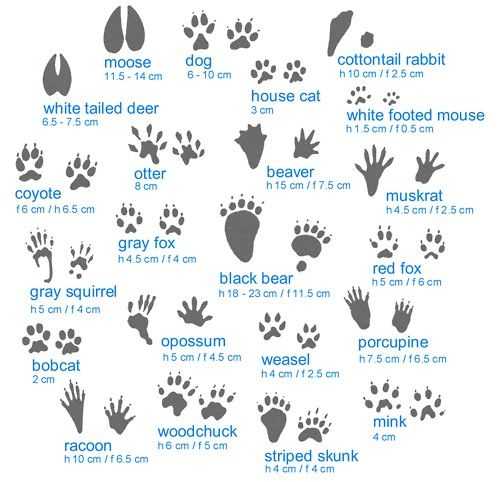
Related: Identifying Animal Tracks
Paths
Most animals are creatures of habit. They move between sleeping, eating and watering areas as part of a daily routine, and unless something forces them to change it they tend to use the same routes. Many wilderness areas have game trails that are regularly used by many animals of different species. The ground may be worn bare or show lots of tracks; it could even be worn into a trough. Vegetation along the path could be battered, or if the trail’s been in use for a long time there might be a clear tunnel through the vegetation. Look for tufts of hair or feathers caught in branches along the trail, especially at narrow points and corners; that can tell you what kind of animals are using it.
If the ground doesn’t show a lot of wear or tracks, and the vegetation has been roughly smashed down, that probably means this isn’t a regularly used track. It’s more likely to be a path broken by an animal fleeing a predator.
Beds and Dens
A bed is where an animal regularly sleeps. Usually it’s underground or in thick undergrowth, for solitary animals. Animals that live in groups might sleep in the open where they can protect each other more easily.
A den is where an animal gives birth and raises its young. If you find a lot of bones or hair around a suspected den that could mean a predator with cubs – probably a good place to avoid.
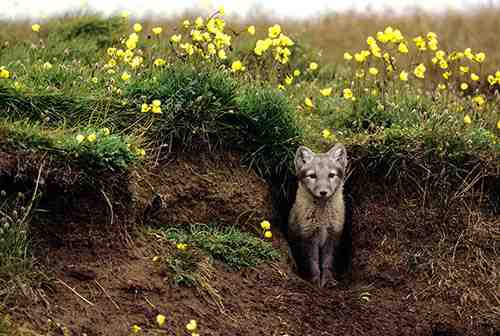 Kills
Kills
Predators leave distinctive sign, and kills are among the most useful. Carcasses that have been torn apart suggest wolves or other canids. Neater corpses, often with the muscles stripped away almost surgically or the innards removed through a hole burrowed through the anus, probably mean a cat. Be wary if you find fresh predator kills. If there’s meat left on the carcass the animal could still be around, and in close country you might not get a lot of warning if it thinks you’re trying to steal its kill.
Watching the Weather
Nature has many signs that can help you with both short and long term weather forecasts. They’re not 100% reliable, but then neither are modern scientific forecasts. Those still have an edge, but nature can serve you pretty well.
Sky Signs
Weather basically comes out of the sky, so this is a good place to start looking for clues. Remember the old rhyme:
Red sky at night, sailor’s delight
Red sky at morning, sailor’s warning
This isn’t foolproof, but it’s a good rough guide. A red or pink sunset usually shows that the sun is lighting up dust in the atmosphere, which generally means a high-pressure system and warm, dry air. A red sunrise means something very different. That’s more likely to be moisture in the air, showing low pressure coming out of the east – where most storms come from in the USA.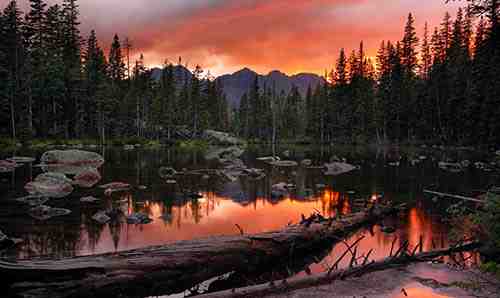
If the moon’s up, study it carefully. If it has an orange color there’s probably dust in the air – which means good weather. If there’s a fuzzy ring round it this probably means rain is on its way; moisture in the air is refracting the moon’s light. If it’s bright and clear, that doesn’t tell you much in summer. In winter, however, it usually means cold, dry weather.
A wind blowing out of the east can mean a storm approaching; if it’s from the west there’s much less risk of that. Any wind means air is moving from high to low pressure areas, though, so it’s generally a sign that the weather’s due to change.
Animal Antics
Animals can tell you a lot about the weather; they’re much more sensitive to changes in pressure than we are, so often they can tell you what’s coming. If you have a cat, watch it when it washes. They usually don’t wash their ears, but a cat’s ears are very sensitive to pressure, so if it’s rubbing them it means the weather will probably change soon.
Birds also have sensitive ears. If they’re flying high you can probably rely on at least two or three days of good weather. As the pressure drops, signaling the approach of bad weather, they’ll fly lower to avoid pain in their ears. If they stop flying altogether and take shelter in trees when you’d expect them to be active, a storm could be just a few hours away.
Seasonal Signals
Many animals also seem to be able to predict the weather on a longer scale. Scientists have no idea how they do this, but nevertheless it happens. If squirrels and other rodents start stockpiling food early, that can mean a long, hard winter is coming. The same goes for animals that hibernate. If they settle down earlier in the year expect a long cold spell. Learn when your local migratory birds usually fly south; if they go early, stand by for a freeze.
Even pets can predict a hard winter. If they’re growing thicker coats than usual as late fall passes, winter could be colder than usual.
Poison Plants
Finally, there are signs that can stop you ingesting a lethal dose of cyanide or alkaloids. A lot of plants have evolved poisons as a defense against being eaten. The problem with that is an animal can eat quite a lot before the plant’s toxic revenge kicks in and kills it, so it makes sense for poisonous plants to signal the fact they’re unsafe to eat. One common way of doing that is with bright colors – so if you don’t recognize a fruit, and it’s bright red or yellow, you’re probably safer avoiding it.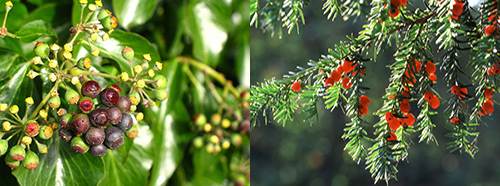
If you need to forage for plants and there’s an unfamiliar one that you think might be edible, taste a tiny piece then immediately spit it out. If it tastes of almonds, steer clear; it contains cyanide, and you really don’t want to be ingesting that. If there’s a burning or stinging sensation on your tongue that’s a warning of alkaloids, and those are something else you definitely want to avoid. If you don’t get either of these signals eat a slightly larger piece and wait for half an hour. No sign of nausea, dizziness or any other unpleasant sensations? Eat a small handful and wait another hour. If you still don’t have any poisoning symptoms the plant is safe to eat.
Do not try these tests on mushrooms or other fungi – they don’t work. Fungi aren’t plants, so tests for poisonous plants don’t work on them. Some of the most lethal mushrooms have plain or even drab colors, and the toxins they produce don’t have any distinctive taste or irritation; they just kill you. Don’t eat any fungi you can’t positively identify as a safe species; you’re basically playing Russian Roulette, except Death Cap poisoning is a lot less pleasant than shooting yourself in the head.
Related: Top 8 Deadly Plants in the U.S. That You Need To Avoid
This is just a small sample of the information you can get from reading nature’s signs. If you spend time outdoors, you’ll soon start to pick up even more useful knowledge. Talk to outdoor people every chance you get; even if you’re a veteran hunter or stockman yourself, there’s always more to learn. And, unlike most of the garbage that’s on the internet, all of it is useful in real, practical ways.
You may also like
How to Use Acorns as Survival Food
If You Are to Weak to Prep then You Need to Watch This (Video)

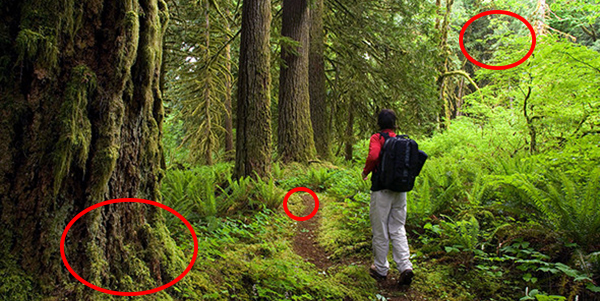














WOW!!! So much useful information in one email. This site just keeps getting better and better. The knowledge contained in these message is priceless.
Good information. I am curious, however, where the idea that most storms in the US come from the east. I live in the Southwest and not one storm ever comes from the east. Literally, ever. I would say it is far more likely that MOST of the US experiences storms originating from the northwest or west and occasionally the southwest, but almost never the east. The east coast states might be the exception to this rule on occasion, but even then rare at best. I have recently been testing the theory of red sky morning and night and find it to be somewhat reliable. Basically, if there are clouds in the sky, either sunrise or sunset could be quite red, but if the clouds are in the sky in the morning, changes are coming!
I agree with you, Dusty. On the West Coast, most storms come in off the Pacifc, generally from a northwest to a southeast direction. During the summer we sometimes get monsoon storms that come up from Mexico, but that is only in the summer. After the storms leave the West Coast, they move in an easterly direction, either across the country or sometimes peter out in the midwest.
I remember as a child living in Pennsylvania we would get storms called noreasters that came in off the ocean, but my 70 year old memory is that most storms did not come from the east. Watching weather reports it seems to me most weather on the East Coast come from directions other than the east.
Dusty, you and Chuck are correct. Cooler air moves down from the polar region. The jet stream moves the air masses from west to east. Low pressure is typically associated with “warmer moist” air. High pressure is “cooler dry” air. Tropical air masses coming up from the south will bring in more moisture if coming from the oceans. Drier air comes from the continental sides (up from Mexico or down from central Canada).
Here in Indiana, the wind from the east usually (and I emphasize usually) means a nasty storm is a few hours away. Lots of times bad weather from the west/southwest will back in on us from the east after it hit us from the west. There is no constant on directions from which the weather hits us, just patterns that can and are changeable.
I agree. Here in Oklahoma, storms come from the west. Some winter weather swoops down from the north.
I agree with you, and I live in South central Al.
Storms generally move from West to East across the U.S. https://pmm.nasa.gov/education/content/why-do-storms-generally-move-west-east-usa
Depends on type of storm. Hurricanes come from the east or southeast in hot weather. Cold fronts come from the Northwest to North.
Curious. In the picture with the foot prints, I didn’t see any Bigfoot tracks. 🙂 Great job. Good clarification. Keep up the good work. It’s appreciated.
As a rule if there’s a nasty rain or snow storm coming from the westerly direction, the wind does blow from the east approx 24 hrs before the storm arrives in Ohio n it usually is very damp or very bitter cold. Im sure there is a reason for that I just never researched it
There are quite a few problems with the whole moss thing. As an eagle scout and avid hiker more often then not I find that moss is NOT a reliable source as an indicator for north. Also according the the universal edibility test you should first put some on your skin and wait an hour or more for a reaction, then you proceed to put a very small amount on your tongue, and wait longer. If you still don’t have any funny feelings, proceed to eat a larger dose perhaps a berry and then wait 8 hours. If you do not have any affects by then it should be edible. The final step is to eat a small handful and wait another few hours to see if a larger quantity makes you sick. Now you see the problem with this test though. In a survival situation you might have to take the gamble a lot soone. If you wait longer, you might die. It’s best to therefore know if you can all the edible plants in your area.
The best test is know your plants before you need them.
Yes, know the plants. Tasting or even putting some on your skin can be very dangerous. The Universal Edibility Test is a very bad idea.
As a cat owner, I can assure you that cats wash their ears regularly. Each time a cat grooms its face (multiple times a day) the ears get at least a cursory going-over. This is not a good predictor of weather.
Also, in the Midwest our bad weather almost NEVER comes from the east. Artic blasts from the north, moisture pulled up from the Gulf of Mexico, & winds from the west shape almost all of our weather.
Just a couple items:
First off, a lot of storms come to Montana from the Northwest, yet the really nasty ones will swirl around and an Easter wind will bring them in very heavy. This used to happen in South Dakota also. The ones from the west were usually not near as bad.
I think it depends on the terrain, as well as the jet streams effects.
Second, I noticed most of the time this person was speaking of keeping the old style thinking patter, not relying on GPS, and other items like Tablets, computers, etc. Yet, when dealing with knowing where you are by the sun, they used the watch, (mechanical type,) for a sure type item.
//The Sun
If the sun’s up, you can always be sure of what direction you’re going in. All you need is a watch or clock that’s set to the right time. An analog watch is best; if you have a digital one you’re going to have to start drawing clock faces in the dirt.
What you have to do is point the hour hand at the sun. Going anticlockwise, half way between the hour hand and 12 o’clock is south (if you’re in the northern hemisphere – if you’re south of the equator it’ll be north). Once you know where south is you have all the rest of the compass points too. As long as you update every 30 minutes to an hour this method is easily accurate enough for emergency navigation. If you’re lost in the woods and need to find the way out, for example, this will do it.//
What if the watch is broken, or we do not use a watch? This appears to be using modern items for a type of thinking of the old ways. We can use the sun, (if it is shining,, to determine what direction we are going by simply standing still for a while to see which way the sun is headed. It does not take that long to see if the sun is going further to your left, or right, to determine if you are headed East or West, North or South.
The moss on the north side of tree trunks is EXTREMELY unreliable. I cannot believe you are listing this as a fact. In damp woods, moss is everywhere.
Sun position is also VERY different in the Far North. When we lived in Alaska, although I am an experienced outdoorswomah, it was hard to orient myself just by sight and feeling, as I did in the Lower 48. Or guess approximate time. The sun appears to go in a low circuit around you, not overhead from east to west. Especially in summer, the sun where we lived (100 miles south of the Arctic Circle) came up in the NNE and set only a few degrees away at the end of a 23 hour day, in the NNW at almost 2AM. I am sure that calculating the sun’s angle with a watch etc would work, but just my ‘woods sense’ didn’t work there.
And finding animal tracks and identifying them is a bare beginning. Even with years of experience, hunting is not always successful unless you know the area and animal habits for a long time. Many tribes have starved especially in the winter despite millenia of accumulated knowledge. Surviving is hard work based on experience NOW. Not when things get bad. End of sermon…